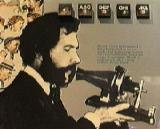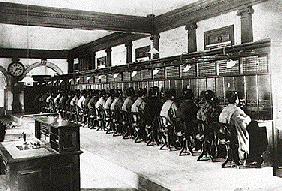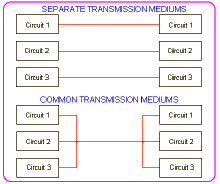![]()
DATA
COMMUNICATIONS
© Copyright Brian Brown, 1995-2000. All rights reserved.
Part 2: The evolution of modern tele-communication networks
Objectives
At the end of this section you should be able to
![]() Evolution of Modern Communications Networks
Evolution of Modern Communications Networks
Data communications concerns itself with the transmission
(sending and receiving) of information between two locations. In
the information age, this means sending information between
machines that are connected together by physical wires or radio
links.
The history of modern electronic communications begun with Alexander Graham Bells telephone experiments, where speech was able to be converted into electrical energy, transmitted along physical wires and reconstructed at the receiver. Speech, which is actually vibration of the air, vibrated a paper cone to which a small coil was attached. This induced an electrical signal into the coil, which was proportional to the vibration of the paper cone.
 |
As you can see in the animation on the
left, the sound waves caused by speech make the paper
cone move. The paper cones movement is directly
proportional to the strength of the air waves caused by
speech. As the cone moves, the coil of wire also moves, being attached to the cone. Inside is an iron bar which helps to increase the effect. A corresponding electrical signal is created in the coil, which can then be sent along a pair of wires to a receiving device that would convert the electrical signal back into sound waves (vibration of the air). |
| Alexander Graham Bell, born in Edinburgh, Scotland,
1847, emigrated to the United States, settling in Boston.
Bell, interested in the education of deaf people,
invented the microphone, and later, in 1876, an electrical
speech machine, called the telephone. By 1878, Bell set up the first telephone exchange in New Haven, Connecticut, and in 1884, long distance connections were made between Boston, Massachusetts and New York City. |
 |
In these early experiments at transmitting speech. copper wire was used as the connection media over which the signals traveled. This is due to copper wire being a very good conductor, which lets electrical signals flow down the wire easily.
As the telephone became popular, more and more people wanted to communicate with each other, so a switching center (telephone exchange) evolved. Each customer was connected to the telephone exchange via a pair of wires, which carried the signal from their telephone.
| As the need to inter-connect telephone customers grew, they were connected via overhead wires to a central switching center, where the physical wires from each customer was connected to the physical wires of another customer via a manual operator. |  |
 |
As more and more customers were connected, the need for more and more operators to connect calls were required. This quickly became unworkable, so development began on automating the connection process between customers, hence, automatic telephone switching exchanges became a reality and replaced local operators, who were still used to connect toll (long distance) calls. |
The customers wires from their home to the telephone switching center were overhead, installed in the same way as a lot of existing electrical (power) wires are today, on top of long poles inserted into the ground, about 15 or so feet high. This quickly became very cumbersome and difficult to manage. Transmission quality was affected by the weather, as the rain created leakage paths for the signals to go to ground instead of along the wire.
 |
File Print: Wellington. Telephone
Exchange. 1894 Creator: Photographer Unknown Description: The manual telephone exchange at the north end of Stout Street, Wellington. Date: 9 January 1894 This photograph must be acknowledged to the J M Lander Collection Reference Number: F-115589-1/2- Collection Reference No: PAColl-0715 Alexander Turnbull Library, National Library of New Zealand, Te Puna Matauranga o Aotearoa. |
At the same time, demand grew to connect customers who lived further and further away, in rural areas. Electrical signals can only travel so far, and to provide service to rural customers meant using better cable that allowed the signals to travel longer distances. Unfortunately, this was costly, so something had to be done to provide them with service. In addition, customers also wanted to be able to talk to other people in different cities, so there developed a need to interconnect telephone exchanges together.
Rural customers began sharing cables, so that one cable supported a number of customers, either one at a time (which was known as party-line), or at the same time using radio signals to separate each conversation. To interconnect telephone exchanges in distant cities together, work began on using different cable and the use of radio signals over cable such as coax. For rural customers, who lived longer distances from the central switching center, it was too expensive to have a single cable for each customer. The need arose for a single cable to carry the conversations of more than one customer, in this way, customers could share a single cable and thus save the telephone company money. So, within a short time, by using radio signals, each open wire cable could carry up to 12 separate speech conversations, with an optional telegraph (telex) signal. Distance then became a limiting factor, so work began on increasing the distance over which the signals could be transmitted and received. One method was to increase the diameter of the cable (which also makes the cable heavier).
| The cost of cable was very high, and
before long special equipment was used to carry more than
one speech conversation on one pair of wires. This was
done by a technique known as multiplexing
(specifically Frequency Division Multiplexing, which
separates each conversion by frequency). This bought down the cost of providing speech circuits (one circuit=one speech conversation) to customers. Whereas previously one cable equated to one speech circuit, now a cable could be equated to hundreds of speech circuits. This allowed an increase in revenue to be collected per cable by the telephone companies. |
 |
For a given cable size and type, the speech signal is affected by loss. In other words, as the signal travels down a cable, part of it is absorbed by the cable and thus the signal arrives at the end of the cable with less strength than when it started (this is called attenuation). It thus follows that if the cable is too long, no signal will arrive at the end, or the signal will be so small that we cannot hear it.
A thicker cable affects the signal less than a thinner cable, so you can go greater distances with a thicker cable before the signal becomes too weak. However, thicker cables cost more and are heavier. Open wire systems were originally made from copper, but the cost became very expensive (and difficult due to the first world war where materials were in sort supply).
Attenuation is a measure of how much loss a signal experiences when it travels down a communications medium. Part of the signal is dispersed as heat, or absorbed by the communications medium. Not all of the transmitted signal arrives at the receiver. Attenuation is measured in decibels (dB). A loss of 3db means half the signal is lost by the time it reaches the receiver. The longer the distance that the signal travels, the greater will be the attenuation that the signal suffers.
Open wire copper systems gave way to open wire systems using aluminum. These cables had to be a great deal thicker because aluminum is not as good as copper (it affects the signal more), but it was lighter and cheaper. The other problem is that aluminum suffers from oxidization when exposed to the air, and this also affects the signal as it travels along the cable. Aluminum cables began to be used during the second world war, when copper became scarce.
Open wire systems, being exposed to the weather, often failed during wet weather and storms. They were often struck by lightning and falling trees. It wasn't long before open wire systems serving rural customers were replaced by other forms of communication systems.